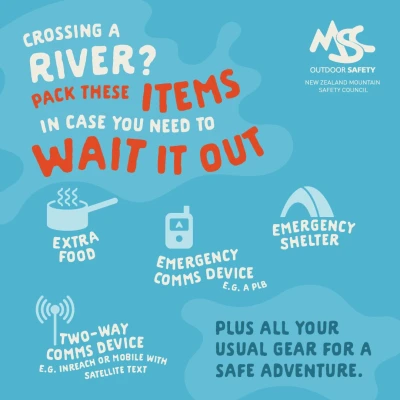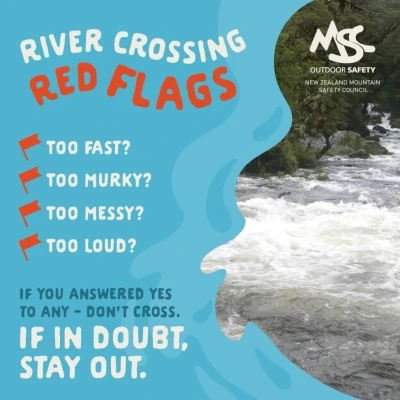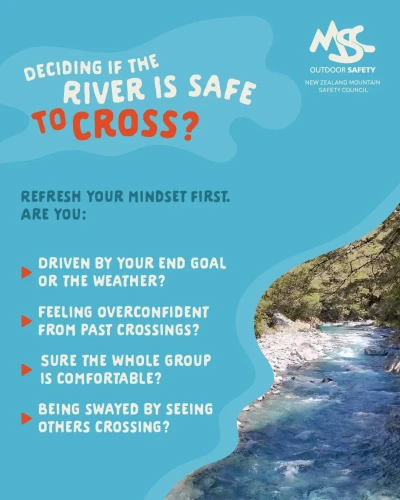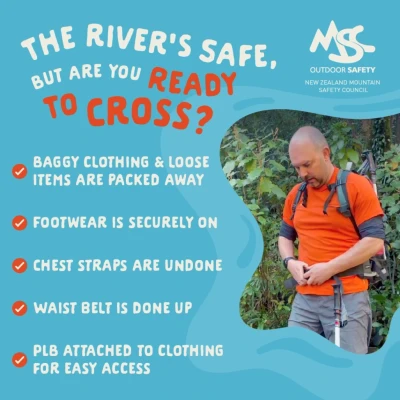Safe or Sketchy? Hunters Urged to Get Prepared for Rivers
Heading out on a spring hunt? Before you go, give some thought to river crossings and whether you need to brush up on your skills. Spring brings more rain and snow melt, so river levels can rise quickly. A stream that was easy to cross on the way into the hills, could be risky on your way out.
Here’s how to avoid a sketchy situation and make smarter choices when you’re out on a hunt.
Check the forecast
Spring weather is anything but reliable. Check the forecast during your planning and again on the day. Look at rain in the river catchment area, not just where you’ll be hunting, as rain upstream will soon make its way down the river. If it’s looking grim and heavy rain is expected, have a plan B or delay your trip so you don’t get stuck by a raging torrent.
Be ready to wait it out
If a river has risen on your way out of the bush, you could find yourself stranded and frustrated. You want to have the gear so that if the river is up, you can wait it out in style or turn back and enjoy another night in the hut. Always pack:
- extra day's worth of food
- emergency shelter
- emergency comms device, like a PLB
- two-way comms device, like inReach or mobile with satellite text, so you can let your emergency contact know that you've been delayed.
Know the signs of an unsafe river
Knowing when a river is unsafe to cross is the first step in river safety. Take time to check for any of these signs:
- Too fast? Moving faster than normal walking pace?
- Too murky? Is the water brown and dirty?
- Too messy? Logs, branches or other debris in the water?
- Too loud? Do you hear roaring water or rolling rocks?
If you answer yes to any of these questions, don’t cross. Remember: if in doubt, stay out.
Be aware of the mental game
Even if you know the signs of an unsafe river, it can be tempting to risk crossing if you’re tired and the end is in sight. By considering the psychological factors and being mentally prepared to wait it out or turn around, you'll be less likely to throw yourself into a risky situation.
Check that you’re in the right mindset to make a safe decision with these five questions.
- What’s driving your decision? Consider what might be influencing your decision-making and whether you are putting other factors ahead of your safety. Is this a good weather window that you don’t want to miss? Are you on the home stretch and keen to get to your destination for the night?
- Crossed here before? If you’ve crossed the river safely in the past, that experience could lull you into a false sense of security. Approach each river with fresh eyes and thinking.
- Everyone in the group comfortable crossing? Make sure everyone has the chance to speak up, not just those with experience. If you’re worried, make your voice heard.
- Are you being influenced by others? Just because others have crossed the river ahead of you, doesn’t make it safe for you. Use the evidence available to you and take into account your skills and experience.
It’s safe to cross. Now what?
If the river passes all your checks, these techniques will help get you cross safely.
Before crossing
- Leave your footwear on to give you more stability and protect your feet.
- Remove any baggy clothing (like rainwear) and stow it in your pack to reduce drag.
- Secure your rifle to the side of your pack or over your shoulder facing downstream, and put away any other items that are attached to your pack.
- Undo the chest strap and loosen the shoulder straps on your pack so you can slip it off easily if you need to.
- Keep your waist belt done up to keep the pack balanced. As long as your pack liner is sealed, it will act as a flotation device if you lose your footing.
- Clip your emergency communication device securely to your clothing so if you need to ditch your pack, you can still call for help.
- Choose an exit point that everyone agrees on.
Crossing techniques
- Keep side on to the current to reduce resistance.
- Keep your feet wide.
- Don’t lift your feet too much – take small shuffling steps.
- Move diagonally downstream, looking ahead to your exit point.
- For groups, always use the mutual support method.
- If travelling solo, use a sturdy pole and the correct solo crossing method.
Crossing as a group
The mutual support method is the safest way to cross a river if you are in a group of two or more people.
- Put your strongest person upstream to break the force of the water, followed by less confident members. If you have more than two people, put another strong person on the downstream end.
- Stand in tight formation side by side and place your arms between the back and pack of the person next to you, grasping the hip belt or, if not wearing a pack, their clothing.
- Practise on land first and agree on signals to turn back in case the river is too noisy to be heard.
- The upstream person will lead the crossing, moving slowly so the group can keep pace, and stopping for anyone who loses their footing to regain their balance.
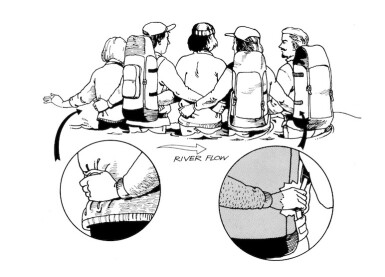
Crossing solo
The solo method of crossing a river is best with a sturdy 2-metre pole. The pole will act as a third leg.
- As you move into the river, hold the pole in both hands in front of your body.
- Push the pole into the riverbed on a 45-degree angle in front and upstream from your feet, and find a strong placement where it will not slip. Use the pole to help you balance as you move each foot forward.
- With your footing placed securely, move the pole forward again and repeat until you are at your exit point.
Explore our river safety resources
- River safety | Learn essential river crossing skills
- Know how to cross | Watch our river crossing safety video
- Get the training | Find a river crossing course
PHOTO CREDIT | Simon Gibson| Fiordland River
This article also appeared in Hunting & Wildlife magazine
